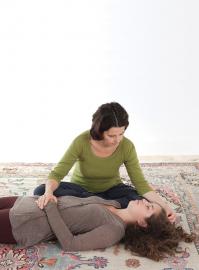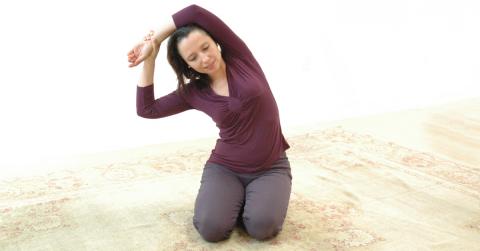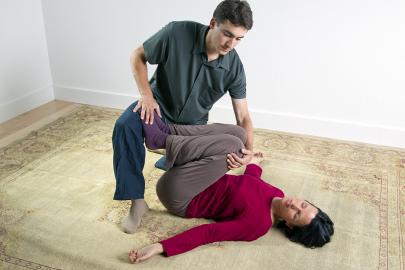
Those who receive Breema bodywork describe it in the most nurturing of terms. and often speak of a subtle yet profound sense of harmony that extends into their daily lives. As valuable as this is, it's more than just the recipient's experience, or its observable effects, that makes Breema meaningful. The essence of Breema lies in what it gives to the practitioner. Breema offers a direction, and the bodywork and principles are tools to support that direction. Breema functions as a foundation for a practical, embodied exploration of who we really are and of the meaning and purpose of our lives. Even the name Breema reflects this deeper aim and purpose through a poetic acronym: Being, Right now, Everywhere. Every moment, Myself. Actually.
That's a tall order, but Breema approaches it in the simplest, most grounded of ways-by bringing the mind to the activity of the body. Every Breema session starts the same way. The practitioner comes to their own body by registering the weight of their body and their own breath. As we practice this simple registration over and over, we may experience an actual taste, rather than have an assumption, of being alive.
Part of the challenge of being human stems from the fact that we have three centers-mind, feelings, and body-and rarely are they working together. 1!1e mind is constantly lost in automatic thoughts and interpretations of "shoulds" and "shouldn'ts;” while the feelings shift between fleeting desires and reactive emotions. 11lis non-stop, energy-draining process goes unnoticed because it is so habitual. Often there is conflict, like when I want to do something I believe is bad for me. Whether I give in or resist, still there is a war going on. Amidst this hubbub, the body is usually ignored, at least until it protests with pain. In this scenario, I'm passive and not available to experience how I really am or how things really are.
Breema is the art of being present, and it approaches this challenge very simply: begin to be active, rather than passive. by bringing your mind to be with whatever your body is doing. The most accessible way is via breath, by keeping mind with the process of inhalation and exhalation. Most people when asked if they know they're breathing quickly reply, "Of course I'm breathing, if I weren't, I'd be dead." Indeed, breathing is a fact of life. But a mentally known fact and an experience of life are completely different.
After bringing the mind to register breathing or another activity of the body for a while, the feelings join in and the three centers come together in harmony. Then we have mind, body and hear t united in one common aim-simply to be. to participate in life. With this shift, we become receptive. We may experience the actual taste that we are alive.
Practicing Breema and Self-Breema helps us to come back to ourselves, to be at "home." As additional support, we work with the Nine Principles of Harmony: Body Comfortable, No Extra, Full Participation, No Force. Mutual Support, Firmness and Gentleness, No Judgment, Single Moment/ Single Activity, No Hurry/No Pause. These universal principles offer an inroad to becoming present. They are at the core of Breema and they work on many levels.
Take Mutual Support, for example. The support of working with another body is tremendous. When I watch a movie or talk on the phone, I almost never remember to be present. But when I give someone a Breema session. their body supports by being a constant reminder to be interested and engaged in the activity of my own body. As Jon Schreiber, Director of the Breema Center and the Breema Clinic, writes in Breema and the Nine Principles of Harmony,
Any time you give support, Mutual Support is taking place, because you are receiving support simultaneously.
The very movements of Breema are based on mutual support. When I raise a client's legs and lean back, the support of their legs keeps me from falling, and they receive exactly the right amount of stretch, because those are determined, not by the mind or external ideas, but by the specific interaction of our bodies in that moment. AS I work more with the principle of Mutual Support, I see evidence of it everywhere. Again, from Schreiber's book:
When you recognize any phenomenon without commentary, Mutual Support is taking place. Say you have recognition of your body breathing. Where did you get this body? How is it able to breathe? The more you look, the more you see you are constantly receiving the support of Existence, every moment of your life.
I have found a lot of value in verifying this statement in my own life.
The practitioner works with the Nine Principles for the purpose of being present, of coming to the taste of life directly experienced in this moment. Why is taste so important? Because everything else is imaginary. This is why Breema distinguishes between thoughts, feelings, sensations, and taste. Thoughts lead to more thoughts, feelings lead to other feelings. and sensations lead to other sensations. They are temporary and lead us into an imaginary past or future. But when I have a taste. I know it in this very moment. and by witnessing that taste via the activity of the body, nothing can take that knowing away from me. Taste may be given while knowing that my body is simply moving from side to side as I give Breema. now leaning, now holding. now releasing. If I notice I'm using force, I've moved back into thought. No Force, No Judgment, Full Participation, or any of the other principles, give me direction. They are my guides in coming back to taste. When I'm fully participating, I'm nowhere else and there's nowhere I'd rather be.
Although Breema bodywork and Self-Breema have therapeutic effects on the physiological body as well as on the mind and feelings, Breema asks us to let go of the idea that we can change or fix someone, including ourselves., and shows us that the most powerful tool for healing is the body's own instinctive wisdom. Whether giving or receiving. Breema's movements are a language that communicates directly, activating that instinctive wisdom. The body is a dynamic system of inconceivable complexity. Rather than focusing on illness and imbalance, Breema supports vitality. I t does that by bringing more balance and harmony to the body, but through movement, atmosphere, and presence) rather than through a diagnostic, mechanistic approach. This brings us right back to presence, for being present with someone without judgment, is the highest gift we can offer.
And this brings up the real purpose of giving and receiving Breema bodywork-the wish to live a conscious, awake life, in harmony with all living things. The desire to nurture well-wishing over competition and comparison, envy and fear. The wish to be present, and bring taste into my daily life. Breema is a practice to bring body, mind, and feelings together in order to move toward the deepest desire of the heart-knowing the essential unity of Existence.
*Breema, the Art of Being Present was written by Marcie Romano and originally published in The Center Post.

